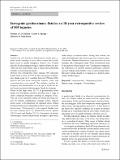| dc.contributor.author | Raassen, Thomas J. I. P. | |
| dc.contributor.author | Ngongo, Carrie J. | |
| dc.contributor.author | Mahendeka, Marietta M. | |
| dc.date.accessioned | 2022-08-20T12:53:14Z | |
| dc.date.available | 2022-08-20T12:53:14Z | |
| dc.date.issued | 2014-12-25 | |
| dc.identifier.other | DOI: 10.1007/s00192-014-2445-3 | |
| dc.identifier.other | PMID: 25062654 | |
| dc.identifier.other | PMCID: PMC4234894 | |
| dc.identifier.uri | https://repository.amref.ac.ke/handle/123456789/783 | |
| dc.description | Open Access This article is distributed under the terms of the Creative
Commons Attribution License which permits any use, distribution, and
reproduction in any medium, provided the original author(s) and the
source are credited. | en_US |
| dc.description.abstract | Introduction and hypothesis: Genitourinary fistula poses a public health challenge in areas where women have inadequate access to quality emergency obstetric care. Fistulas typically develop during prolonged, obstructed labor, but providers can also inadvertently cause a fistula when performing obstetric or gynecological surgery.
Methods: This retrospective study analyzes 805 iatrogenic fistulas from a series of 5,959 women undergoing genitourinary fistula repair in 11 countries between 1994 and 2012. Injuries fall into three categories: ureteric, vault, and vesico-[utero]/-cervico-vaginal. This analysis considers the frequency and characteristics of each type of fistula and the risk factors associated with iatrogenic fistula development.
Results: In this large series, 13.2 % of genitourinary fistula repairs were for injuries caused by provider error. A range of cadres conducted procedures resulting in iatrogenic fistula. Four out of five iatrogenic fistulas developed following surgery for obstetric complications: cesarean section, ruptured uterus repair, or hysterectomy for ruptured uterus. Others developed during gynecological procedures, most commonly hysterectomy. Vesico-[utero]/-cervico-vaginal fistulas were the most common (43.6 %), followed by ureteric injuries (33.9 %) and vault fistulas (22.5 %). One quarter of women with iatrogenic fistulas had previously undergone a laparotomy, nearly always a cesarean section. Among these women, one quarter had undergone more than one previous cesarean section.
Conclusions: Women with previous cesarean sections are at an increased risk of iatrogenic injury. Work environments must be adequate to reduce surgical error. Training must emphasize the importance of optimal surgical techniques, obstetric decision-making, and alternative ways to deliver dead babies. Iatrogenic fistulas should be recognized as a distinct genitourinary fistula category. | en_US |
| dc.description.sponsorship | African Medical and Research
Foundation (AMREF), EngenderHealth, the Fistula Foundation, the Freedom
from Fistula Foundation, Gesellschaft für Technische
Zusammenarbeit (GTZ; now GIZ), Johnson & Johnson, the Royal Netherlands
Embassy of Tanzania, SOS East Africa, United Nations Population
Fund (UNFPA), Women and Health Alliance International
(WAHA), The United States Agency for International Development
(USAID), through Engender Health’s Fistula Care project | en_US |
| dc.language.iso | en | en_US |
| dc.publisher | Springer | en_US |
| dc.subject | Cesarean section | en_US |
| dc.subject | Genitourinary fistula | en_US |
| dc.subject | Hysterectomy | en_US |
| dc.subject | Latrogenic | en_US |
| dc.subject | Ureteric injury | en_US |
| dc.title | Iatrogenic Genitourinary Fistula: An 18-year Retrospective Review of 805 Injuries | en_US |
| dc.type | Article, Journal | en_US |

